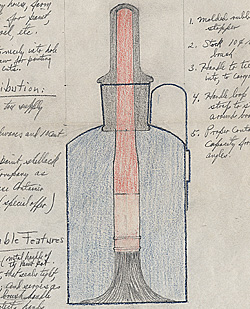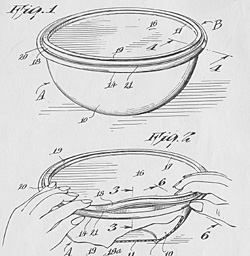|
return
to list of innovators
INNOVATORS
GALLERY
 Earl
Silas Tupper (1907-1983) Earl
Silas Tupper (1907-1983)
Born: Leominster, Massachusetts or New Hampshire (?)
Inventor/Businessman
-
Raised on a farm, Tupper built devices that made work around the
family's farm and greenhouses easier. He even earned a patent
for a frame used to help clean chickens. Tupper also showed a
talent for entrepreneurship: at the age of 10, he figured out
how to increase his family's income by selling produce door-to-door,
thereby bringing the product directly to the customer.
- After
high school graduation in 1925, Tupper left the family farm and
worked as a mail clerk and on a railroad crew, and ran a successful
landscaping and nursery business. Whatever the job at hand, Tupper
continued to fill notebooks with scientific inquiries, experiments,
and inventions.
- In
1937, Tupper worked for the plastic manufacturing division of
DuPont for one year, and took the experience he had gained in
plastics design and manufacturing, and struck out on his own,
forming the Earl S. Tupper Co., in 1938.
- During
World War II, Tupper molded parts for gas masks and Navy signal
lamps.
- After
the war, Tupper decided to develop plastics for the growing consumer
market. This was a challenge, however. Plastic products had a
reputation for being brittle, greasy, smelly, and generally unreliable.
By a two-step process of invention, Tupper created one of the
most practical kitchen items to date: the airtight plastic food
container called Tupperware. First, he developed a method for
purifying black polyethylene slag, a waste product produced in
oil refinement, into a substance that was flexible, tough, non-porous,
non-greasy, and translucent. Second, he developed the Tupper seal,
an airtight, watertight lid. Together, these innovations laid
the foundations for the future success of Tupperware.
- In
the late 1940s, Thomas Damigella (in Massachusetts) and Brownie
Wise (in Florida) were selling household products through Stanley
Home Products. Purchasing through local plastics distributors,
both began offering Tupperware as part of their product line,
and were moving enough Tupperware to attract Tupper's attention.
- In
1948, Tupper met with Damigella, Wise, and several others to discuss
a new distribution plan. Modeled on the home party plan pioneered
by Stanley Home Products and expanded and refined by Wise, Tupperware
Home Parties became and remain the exclusive outlet for Tupperware.
Objects:


Compiled
from the following sources:
-http://web.mit.edu/invent/iow/tupper.html
|










